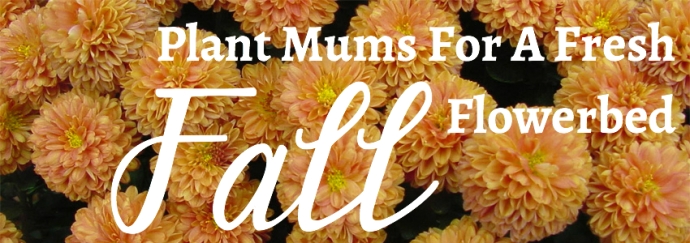 This time of year, avid gardeners are looking for a reason to get outdoors and freshen up their flower beds. And they’re likely doing it using chrysanthemums — or mums for short — late-season bloomers that produce lots of long-lasting flowers in a variety of colors and shapes. Perfect for mass plantings or filling a container, gardeners can play with color schemes of mums that complement existing plantings such as ornamental grasses, beautyberry (Callicarpa), smoke tree (Cotinus), variegated sedum and conifers, while creating instant curb appeal. But first, you need to clean out your flower beds.
This time of year, avid gardeners are looking for a reason to get outdoors and freshen up their flower beds. And they’re likely doing it using chrysanthemums — or mums for short — late-season bloomers that produce lots of long-lasting flowers in a variety of colors and shapes. Perfect for mass plantings or filling a container, gardeners can play with color schemes of mums that complement existing plantings such as ornamental grasses, beautyberry (Callicarpa), smoke tree (Cotinus), variegated sedum and conifers, while creating instant curb appeal. But first, you need to clean out your flower beds.
6 Steps for Easy Autumn Clean-up
You’ll need a rake, garden spade, cultivator, hand trowel, bulb planter, organic compost, peat moss or manure, mulch, wildflower seeds (optional), spring-flowering bulbs (optional) and of course, chrysanthemum plants.
Step 1. Remove summer mulch and compost; deadhead flowering plants and pull up any weeds; rake up leaves and debris.
Step 2. Dig up any annuals by the roots, shaking the conditioned soil back into the bed, and compost only the healthy plants.
Step 3. Groom your perennials by splitting or discarding clumped areas, separating tubers, rhizomes and bulbs and add compost.
Step 4. In addition to planting mums for immediate bloom, plant biennial seeds like hollyhock, foxglove, Canterbury bells and violets and bulbs like hyacinths, daffodils, tulips and lilies. Remember to mark the planting area.
Step 5. Trim back foliage on perennials that like to be pruned in the fall. If you find snails and slugs, keep the cuttings out of the compost heap.
Step 6. Add manure, compost or peat moss before planting. Afterwards, mulch the garden with two to three inches of fresh mulch.
Choosing Mums For Outdoor Planting
Both cutting mums and hardy mums are hybrids of the golden-yellow mum originating from China. Both can be planted in a flower bed, for different reasons. Cutting mums are traditionally used by florists because of their large flowers that come in the most variety of shapes and types, including:
- Decorative: long, tightly overlapping petals that curve up and in toward the flower center or out and down
- Pompon: smallish, globe-shape petal-packed flowers
- Single or Daisy: single row of long petals around a center disk
- Anemone: one or more rows of single flat petals topped with tiny florets of a darker color
- Semi double: two or three rows of long petals around the center disk
- Single Quill: single daisy type with tubular petals
Cutting mums struggle to tolerate the cold and are used as short-term bedding plants to create interest. Hardy mums are, well hardy — they produce the underground stolens that help the plant survive in cold temperatures.
Still, you want to plant mums in a spot that gets at least six hours of sunlight a day, in well-draining soil. Water thoroughly, never letting them wilt. Hardy mums will bloom well into the fall, until the first hard front. Prepare them for winter by mulching up to four inches around the entire plant with straw or shredded hardwood, spreading between branches.
Expert Advice
Our expert staff is always on hand to help you plan your next planting project. From rakes to wheelbarrows, seed and mulch and everything in-between, if you have any questions about what to choose, pricing or how-tos, don’t hesitate to contact us. Stop by our store — we’re open seven days a week.
